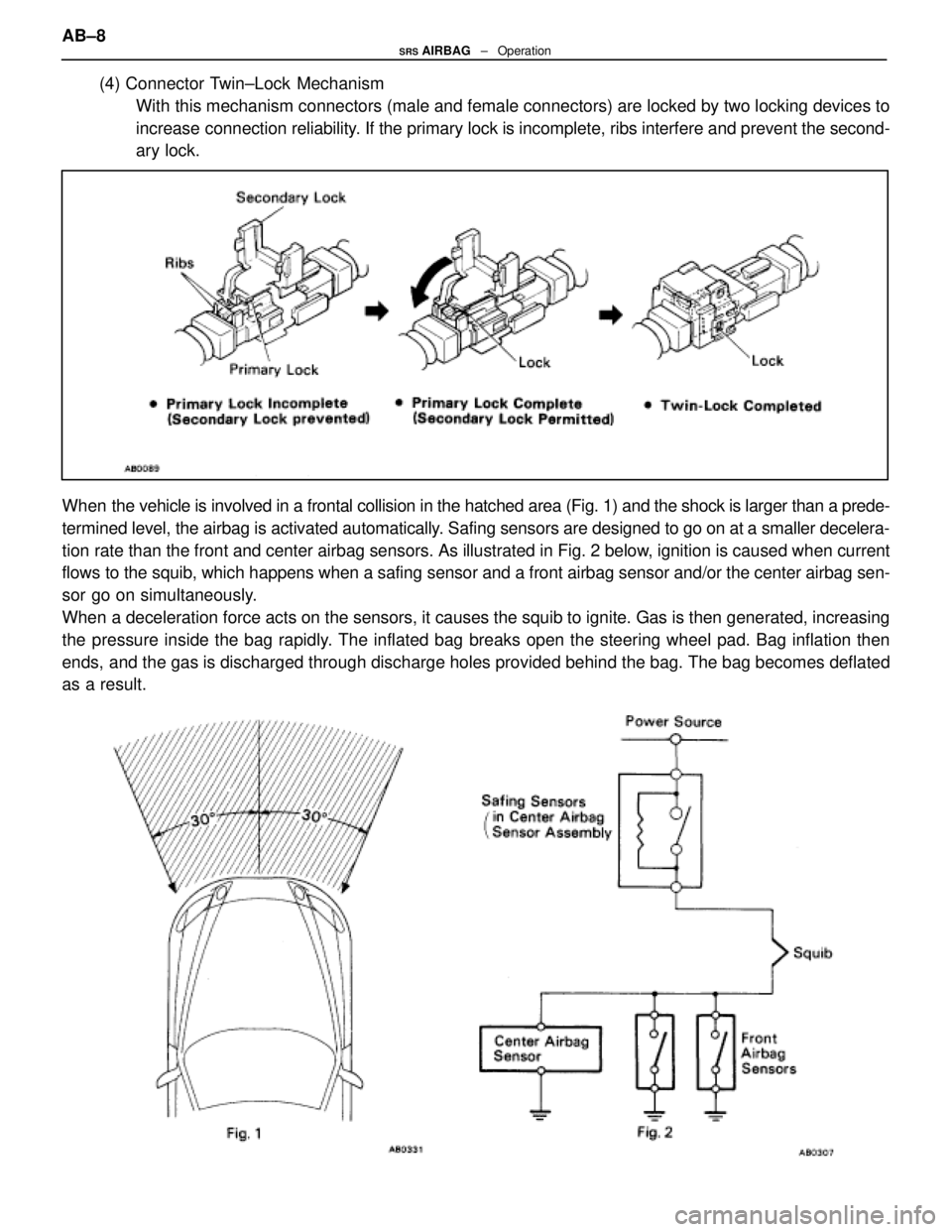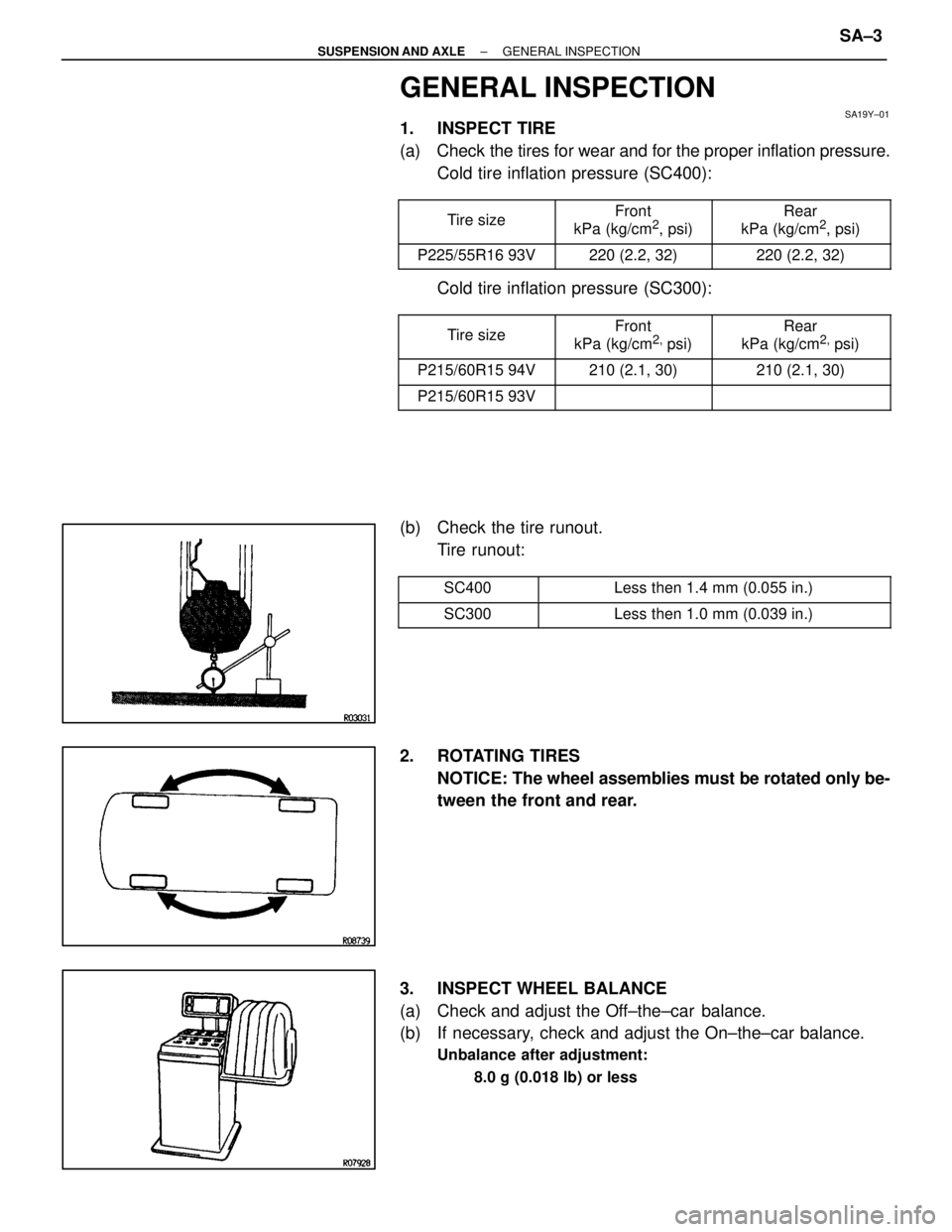Page 222 of 4087

(4) Connector Twin±Lock MechanismWith this mechanism connectors (male and female connectors) are locked by \
two locking devices to
increase connection reliability. If the primary lock is incomplete, ribs interfere and prevent the seco\
nd-
ary lock.
When the vehicle is involved in a frontal collision in the hatched area (Fi\
g. 1) and the shock is larger than a prede-
termined level, the airbag is activated automatically. Safing sensors are designed to go on at a smaller decelera-
tion rate than the front and center airbag sensors. As illustrated in Fig. 2\
below, ignition is caused when current
flows to the squib, which happens when a safing sensor and a front airbag sen\
sor and/or the center airbag sen-
sor go on simultaneously.
When a deceleration force acts on the sensors, it causes the squib to ignite\
. Gas is then generated, increasing
the pressure inside the bag rapidly. The inflated bag breaks open the steering wheel pad. Bag inflation then
ends, and the gas is discharged through discharge holes provided behind the b\
ag. The bag becomes deflated
as a result.
AB±8SRS AIRBAG ± Operation
WhereEverybodyKnowsYourName
Page 3118 of 4087

When the vehicle is involved in a frontal collision in the
hatched area (Fig. 1) and the shock is larger than a predeter-
mined level, the SRS is activated automatically. A safing sen-
sor is designed to go on at a smaller deceleration rate than
the front and center airbag sensors. As illustrated in Fig. 2,
ignition is caused when current flows to the squib, which hap-
pens when a safing sensor and a front airbag sensor and/or
the center airbag sensor go on simultaneously. When a de-
celeration force acts on the sensors, two squibs in the driver
airbag and front passenger airbag ignite and generate gas.
The gas discharging into the driver and front passenger air-
bags rapidly increases the pressure inside the bags breaking
open the steering wheel pad and instrument panel door.
Bag inflation then ends, and the bags deflate as the gas is
discharged through discharge holes at the bag's rear or side.
RS±14±
SUPPLEMENTAL RESTRAINT SYSTEM OPERATION
WhereEverybodyKnowsYourName
Page 3266 of 4087

GENERAL INSPECTION
SA19Y±01
1. INSPECT TIRE
(a) Check the tires for wear and for the proper inflation pressure.Cold tire inflation pressure (SC400):
�������� �
�������
��������Tire size������� �
������
�������
Front
kPa (kg/cm2, psi)
��������� �
��������
���������
Rear
kPa (kg/cm2, psi)
�������� ��������P225/55R16 93V������� �������220 (2.2, 32)��������� ���������220 (2.2, 32)
Cold tire inflation pressure (SC300):
�������� �
�������
Tire size������� �
������
Front
kPa (kg/cm2, psi)��������� �
��������
Rear
kPa (kg/cm2, psi)�������� �
�������
��������P215/60R15 94V
������� �
������
�������210 (2.1, 30)
��������� �
��������
���������210 (2.1, 30)
�������� ��������P215/60R15 93V������� ���������������� ���������
(b) Check the tire runout.
Tire runout:
������� �������SC400���������������� ����������������Less then 1.4 mm (0.055 in.)
������� �������SC300���������������� ����������������Less then 1.0 mm (0.039 in.)
2. ROTATING TIRESNOTICE: The wheel assemblies must be rotated only be-
tween the front and rear.
3. INSPECT WHEEL BALANCE
(a) Check and adjust the Off±the±car balance.
(b) If necessary, check and adjust the On±the±car balance.
Unbalance after adjustment: 8.0 g (0.018 lb) or less
±
SUSPENSION AND AXLE GENERAL INSPECTIONSA±3
WhereEverybodyKnowsYourName